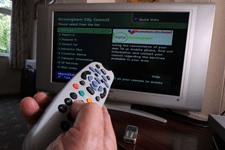Product Info, Sweeps, Coupons Top List of Reasons TV Viewers Interact with Social Media Symbols: Accenture Study
We’ve all seen the social media symbols pop up while watching TV and for marketers trying to engage through this interactive means with the TV viewing audience, things are looking up, but there’s work to do.
 Nearly two-thirds, 64%, of U.S. consumers recalled seeing symbols such as Facebook “likes” while watching television, according to a new Accenture study. And in a sign that consumers are showing some interest, one in three viewers reported interacting with social media after seeing a social media symbol on their TV screen.
Nearly two-thirds, 64%, of U.S. consumers recalled seeing symbols such as Facebook “likes” while watching television, according to a new Accenture study. And in a sign that consumers are showing some interest, one in three viewers reported interacting with social media after seeing a social media symbol on their TV screen.
“This has huge revenue growth potential as social media applications build program viewer loyalty and drive online advertising opportunities,” Robin Murdoch, Accenture's global Internet segment managing director, said.
The survey also found that among the 1,000 viewers surveyed, the majority said they had noticed and were familiar with how to interact with the symbols while they watched TV, including the Facebook “like” symbol (42%), QR codes (28%), Twitter Hashtags (18%) and Shazam symbols (9%). One-third went even further, reporting that they had actually interacted with the symbols while watching TV by “liking” the TV program on Facebook (20%), scanning a QR code (11%), searching for the Hashtag on Twitter (7%) or scanning the Shazam symbol (5%).
Reasons why viewers clicked
The top motivator in actually getting viewers to take action was to obtain more information about a show, product or service cited by 43% of the participants. Other motivations included:
* getting coupons and promotional codes (32%)
* entering a contest or sweepstakes (31%)
* watching another video (26%)
* interacting about the show or product on social media (26%)
* connecting with others with similar interests (21%)
* sharing or recommending video/program to others (20%)
* making a purchase (16%)
Demographic breakdown
It’s no surprise here that the younger the age of the viewer, the higher the interactivity. Some 63% of those between the ages of 18 and 24 said they had interacted with social media symbols while watching TV. For older age groups, the numbers dropped to 46% among 25-34 year olds, 44% among 35-44 year olds, 19% among 45-54 year olds, 24% among 55-64 year olds and 11% of those 65 or older.
When broken out by men and women, most were still interested in getting more information about the show (39% and 48%, respectively). Women were also motivated by getting coupons or promotional codes (40%) and registering or signing up for something (34%). Males were more interested in interacting with social media to watch another video (35%) or entering a contest or sweepstakes (34%).
The results
The survey showed that 74% of those who received content through interacting with the social media symbols said it just “met expectations,” compared with 10% who said the content “did not meet expectations” and 15% who said it “exceeded expectations.”
These somewhat dismal responses reflect another finding; that the greatest barrier to adoption is lack of interest in the content available, with 60% reporting that they did not think they would be interested in the content they would receive. Fewer participants said they were not sure how to interact with social media symbols (23%); had not downloaded the necessary application for scanning social media symbols on their mobile devices (15%); or, did not have time to scan a social media symbol because it was not displayed long enough on the TV program (11%).
What are viewers watching?
Dramas and comedies were found to be the top genres where consumers would like additional information and interactivity. Asked what type of show they would be interested in interacting with, 35% said dramas and comedies, compared to news programming (31%), sporting events (29%), reality shows (23%), lifestyle/cooking/home shows (20%), game shows (19%), talk shows (16%) and live non-sports events (15%).
“The challenge to unlocking this enormous growth is convincing viewers that interacting with TV programming is valuable to them," Murdoch said. "You do that by offering compelling content that enhances the viewing experience coupled with things that extend the value into other areas of their lives. In parallel, you might make social media easier for viewers to use by integrating these capabilities into your existing distribution infrastructure.”
Methodology In March 2012, Accenture conducted an online survey with 1,000 U.S. consumers over the age of 18 to measure their understanding and usage of the social media symbols that appear during television programming. Participants were shown images of various social media symbols and asked a series of questions about their familiarity and use of them while watching television.
































